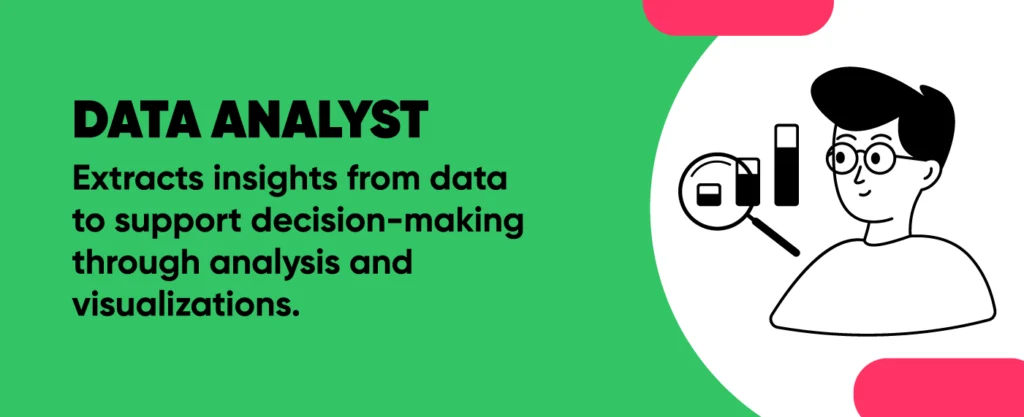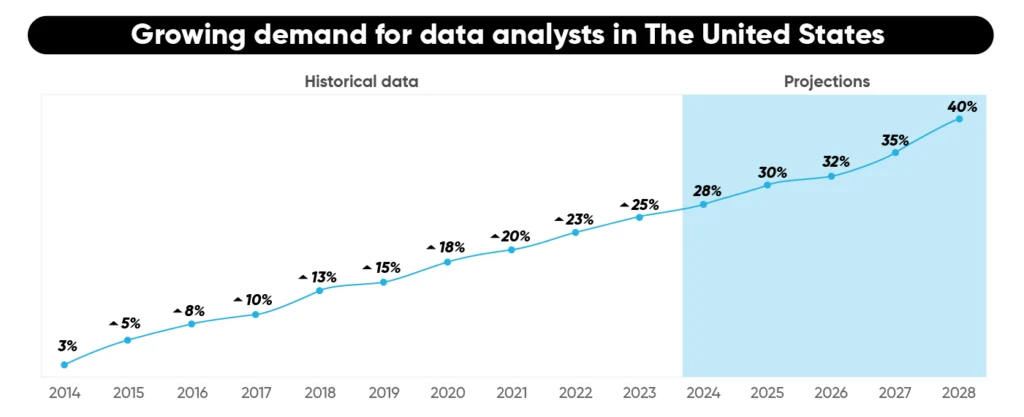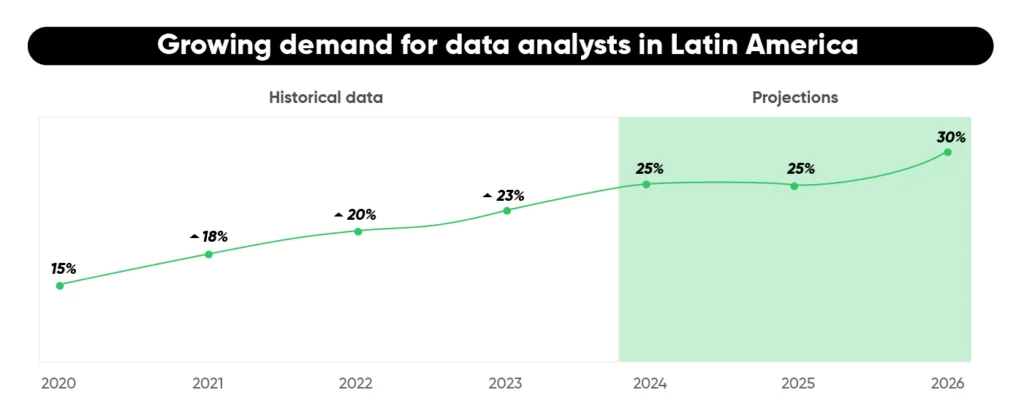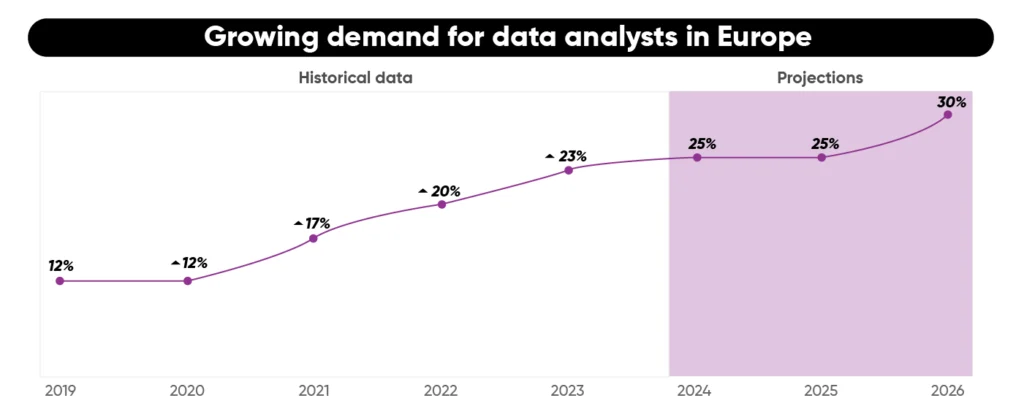The exponential growth of data in companies has led to new specialized roles.
These include data analyst, data architect, and data engineer. While their responsibilities may overlap, each plays a key role in turning data into business value. This evolution supports a core need in innovation and business strategy: transforming scattered data into clear decisions. But new questions arise: Who manages this growing data flow? Does every company need these roles?
How do you structure the data area properly?
Getting the data right is critical in a business environment where data is at the core of strategic decisions. This is why it is necessary to have a Chief Data Officer (CDO) who turns data into a strategic asset that drives the company’s efficiency, innovation, and competitiveness while ensuring its proper management and protection.
This is the person who should design the data profile requirements. However, in companies that are just starting to develop a data strategy, or have developed a strategy that is oversized or no longer meets the needs, it is essential to understand the importance of each role.
It is important to clarify that everyday business intelligence tools simplify the way data is processed, with automatic connections and templates, among other things, which can leave teams behind in terms of requirements.
Here are some suggestions to help you make the right decision on how to structure the data working team in any type of organization.
1. Understand the volume of data you’re working with
The volume of data to be processed may initially seem overwhelming. However, is it really as substantial as it appears? Will all the data provide relevant information for business insights? Can the processing be accomplished using tools already provided by other systems, such as ERPs or CRMs?
2. Difference between a Data Architect and a Data Engineer

While a data architect designs the overall structure and policies of the data infrastructure, a data engineer focuses on building the systems to collect, validate, and prepare high-quality data. Both roles ensure that data analysts or data scientists can extract relevant information for the business. But are both roles necessary?
Current trends have simplified access to information from the source, such as through API connections, which simultaneously reduce and highlight the importance of the data architect. Initially, an external consultant might design the structures, which can then evolve without further input from the original designer.
However, the role of the data engineer is increasingly seen as essential to maintain on a permanent basis within the team. This is due to the fact that, although the infrastructure and connections may be well designed, their ongoing modification can cause overloads or disconnections.
3. Data architecture and data engineering: solid pillars for strategic decisions
In his excellent book, Data architecture and engineering: solid pillars for strategic decisions, Walter Calcagno Lucares outlines the key concepts of both professions, the challenges they address, and the optimal solutions.
A particularly notable point in the book, which is often underappreciated, is the emphasis that data architects must place on information security and privacy.
Beyond various data protection regulations, which in the European Union prompted the creation of the Data Protection Officer role and a public register of certified individuals, there exists an intrinsic business issue within data domains.
Suppose a company has chosen to enhance its value through a data-oriented approach, gaining metrics that enable market growth. In that case, it makes sense that this data would be of higher interest to competitors or external hackers. Investing in data analytics or data science without adequately safeguarding the generated information exposes the company to the risk of theft and potentially severe legal consequences.
Read more → 7 key points to ensure software security
What are the roles in data analytics?
There are many specialized roles in data analytics that help structure, process, and extract value from information. From designing the data infrastructure to interpreting insights, each of these profiles brings unique skills to approach data from different angles. Understanding these roles is essential to selecting the profile that best fits an organization’s needs.
What is the role of the Data Analyst?
Data analysts interpret data to gain insights that support strategic decisions. Their goal is to transform data into actionable information that drives evidence-based decisions.
Technical tasks
- Extract, transform, and analyze data.
- Create reports and visualizations using tools like Power BI, Tableau, or Excel.
- Identify patterns and trends using statistical techniques.
- Use languages like SQL, Python, and R.

What is the role of the Data Engineer?
Data engineers are responsible for building and maintaining the infrastructure needed to manage large volumes of data. Their primary responsibility are to ensure that data flows properly from their source to analytic systems or applications. Ensuring that data is available and ready to be analyzed is their goal.
Technical tasks
- Create data pipelines (ETL/ELT) to move data efficiently.
- Optimize storage and databases.
- Manage data source integration.
- Implement cloud technologies (AWS, Google Cloud, Azure) and distributed systems.
- Master languages and tools such as Python, SQL, Apache Spark, Hadoop, and Kafka.

What is the role of the Data Architect?
Data architects design the structure and architecture of data systems to optimize their management and use. Their goal is to align the data infrastructure with the strategic goals of the organization.
Technical tasks:
- Define data management policies and strategies.
- Design database and storage architectures (data lakes, data warehouses).
- Select appropriate technologies and ensure platform scalability and security.
- Modeling and structuring data to ensure data quality and governance.
Each of the data analytics roles has a specific focus, allowing organizations to build teams with the complete capability to transform data into strategic decisions and measurable results.

Evolution and projection of the demand for Data Analysts in the United States
In the United States, the growth of the Data Analyst role has shown a notable upward trend over the past decade. According to estimates from entities such as the Bureau of Labor Statistics (BLS), LinkedIn’s Emerging Jobs Report, and consulting firms like IBM and Burning Glass Technologies, interest in this field has grown exponentially:
- 2014-2016: Initial growth from 3% to 8% annually, driven by interest in data analytics and the expansion of Big Data.
- 2017-2019: Demand increased from 10% to 15% annually, with notable interest in sectors such as healthcare and finance.
- 2020-2023: With the rise of digital transformation, demand grew by 18% in 2020, reaching 25% in 2023.
- 2024-2026: Demand is expected to increase by 28% in 2024 and reach 32% in 2026, driven by the adoption of advanced analytics in sectors like AI and automation.
- 2027-2028: Demand is projected to reach 38% annually, consolidating in emerging sectors like artificial intelligence and automation.

Evolution and projection of the demand for Data Analysts in Latin America
In Latin America, the demand for Data Analysts has also experienced steady growth, reflected in studies by IDC and LinkedIn:
- 2020-2022: An increase of between 15% and 20%, driven by digital transformation in sectors such as banking, telecommunications, and retail, especially in countries like Brazil and Mexico.
- 2023: A 22% increase in demand, with the healthcare and fintech sectors leading growth in the region.
- 2024-2025: An anticipated annual growth of 25%, with greater adoption of Business Intelligence and Machine Learning in medium to large enterprises.
- 2026: Demand in LATAM could reach a cumulative growth of 30% compared to 2023, especially in Colombia, Chile, and Argentina.

Evolution and projection of the demand for Data Analysts in Europe
According to studies by McKinsey, IDC, and Glassdoor, the demand for Data Analysts in Europe continues to grow, driven by digital transformation and regulations like GDPR:
- 2019-2022: Demand grew from 12% to 20% annually, with significant momentum in the manufacturing and financial sectors in countries such as Germany, France, and the UK.
- 2023: A 23% increase in demand in Nordic and Southern European countries, with a preference for skills in Python and SQL.
- 2024-2025: A 25% growth, motivated by ethical data regulation and the adoption of Artificial Intelligence in analytics.
- 2026: Demand for data analysts could grow by 28%, especially in the healthcare, renewable energy, and cybersecurity sectors.

Where to study Data Analytics?
As data analytics has grown, so have the opportunities to study it. Universities such as MIT and Stanford offer advanced programs, and in Latin America, UBA and Tecnológico de Monterrey have robust programs in data science and analytics. Furthermore, platforms like Coursera, edX, and Udacity provide specialized courses that offer flexibility for professionals in Europe and Latin America who seek to train in a high-quality online environment.
Suscribe to our newsletter!
Will Artificial Intelligence replace the data analyst?
While AI and machine learning can automate certain tasks, data analysts remain indispensable. AI aids in processing large volumes of data and identifying basic patterns, but human analysts bring context, discernment, and deep understanding that surpass mere numerical results. Their role is vital in making strategic decisions and in scenarios where interpretation and market knowledge add irreplaceable value.

Where does a data analyst work?
Data analysts find opportunities across various sectors: finance, technology, retail, healthcare, and more. In the United States and Europe, they work in tech companies and startups, whereas in Latin America they also assist traditional sector companies in adapting to modern data analytics. Their versatility enables them to be changemakers in both large and small companies, helping to convert data into growth and innovation strategies.
Conclusion
Accurately defining the needs and objectives of a company’s data strategy is crucial for achieving the desired success. As the tools for processing data become more streamlined, the prior process of defining the infrastructure becomes even more essential.
At Crombie, we have a team of professionals who can deeply understand the needs of each company, project, and market. With our consultancy, not only will you be able to comprehend the required professionals, but we will also guide you towards the best software solutions.

At Crombie, we help companies build scalable data solutions
We design and implement architectures that enable real-time data integration, transformation, and usage. From efficient pipelines to smart analysis strategies, we help turn data into business decisions.











Leave a Comment